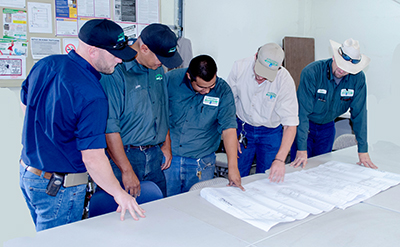
How often do you think about the plumbing in your home and what it’s made of? I’m sure the answer is never. At least not until there’s a water leak or it comes time to either sell or buy a home.
Believe it or not, there isn’t one type of plumbing for every home. There are different types of plumbing in homes, depending on age and what was popular at the time. Depending on the type of plumbing that’s in your home, you may need to consider having a repipe.
What’s a repipe? It’s exactly what it sounds like. It’s where you are having the plumbing in your home replaced, or repiped, with newer and better materials. There are different types of plumbing, such as polybutylene, Kitec, PEX, and copper. We’re here to help explain each one, so you’re better informed.
Polybutylene
Polybutylene is an older type of plumbing that can widely be found in Amrep homes in Rio Rancho. This material was very popular from 1978 to 1995 due to being cheap to obtain and easy to install. However, many homeowners have been and continue to discover the issues with polybutylene (realtors and plumbers call it “poly” for short) and that a repipe is desperately needed. Why is this necessary? Because leaks are guaranteed to happen in homes with poly, and we’re pretty sure the last thing you want is leaks in the walls of your home.
Kitec
This is another older type of plumbing that was used from 1995 to 2007. While it was better than poly, there was still a pretty good chance of a leak. It was used because it was also a cheaper option, and it was thought to be a more efficient alternative. However, Kytec was part of a class-action lawsuit recently for any homes, buildings, and other structures where Kitec had been installed and used. Many people claimed anything from leaks to their water, turning blue from the plumbing. What does Kitc look like? The hot water line is usually red or orange, and the cold line is usually blue. Makes sense, right?
PEX
This material has emerged as the new “it” thing to use in homes. It offers high heat-resistance and is durable. Albuquerque Plumbing prefers to use a type of PEX, called Aquapex, that virtually eliminates problems with leaky fittings, disintegrating pipes, and corrosion seen in older plumbing.
You can find out what kind of plumbing you have by looking under a sink in your home or by running a tiny camera in the wall, such as behind the washer box in your laundry room/closet. You’ll know what you’re looking at by reading the pipes. Most polybutylene pipes will be gray and say “PB,” and Kitec will read, “Kitec” or “KTC.” Pretty easy and straightforward, huh?
Copper
One final repipe material to remember is copper. This is typically more expensive and takes longer to install, but it can also help increase the value of your home. Not only that, but it lasts anywhere from 50-70 years! Talk about an investment for your home!
You’re probably scratching your head and asking the next logical question: How long do repipes take? It depends on the size of the home. The bigger the home, the more time it will take. Regardless of how long it takes, you’ll be happy when the work is done because then you can go back to your usual day to day life.
The good news for you is that the professionals with Albuquerque Plumbing Heating & Cooling are equipped to help you with this doozy of a project. What starts as a free estimate* with our comfort advisors can end with a home that has the best plumbing materials installed by an amazing team. We’re ready to help answer your questions on this task and get your home the plumbing of its (or your) dreams.



